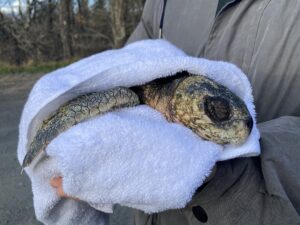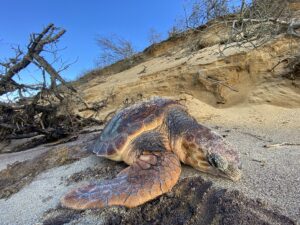WELLFLEET — A few weeks ago, Heidi Clemmer was walking her dog on Corn Hill Beach in Truro when she noticed a sea turtle lying in the sand.
Clemmer, a longtime volunteer with Mass Audubon’s sea turtle team, knew that these “cold-stunned” turtles often wash ashore on bayside beaches between Barnstable and Provincetown. As the sea turtles try to migrate south, some get trapped in Cape Cod Bay as winter sets in and end up drifting to shore, weakened by cold. So, even though she was off duty, she picked up the turtle to bring it back to her car so she could drive it to Audubon’s Wellfleet Bay Wildlife Sanctuary.

On the way, Clemmer spotted another turtle. She picked up that one, too, scooping it under her other arm and carrying them like two sacks of potatoes. And then she spotted a third turtle.
“I had to make two trips,” she said. Spend a whole day walking bayside beaches, Clemmer said, and you can sometimes find three or four stranded sea turtles.
As climate change brings more turtles to our waters, Mass Audubon is relying more on the public to locate these endangered reptiles and keep them alive.
Rising Temperatures and Populations
For sea turtles, the waters of the North Atlantic are perfect in the summer. They migrate south to warmer waters in the fall because the ocean here is too cold for them in the winter.

The unique shape of Cape Cod, however, can trap the turtles in the bay. And as the water drops below 50° F, it weakens the turtles’ ability to fight diseases and makes them sluggish, leaving them drifting with the ocean’s currents. By the time they wash up on shore, they may have hypothermia, pneumonia, and lung infections.
Mass Audubon runs its sea turtle project to help save these turtles. In the late fall, a small group of dedicated staff and 150 to 200 volunteers walk the bayside beaches to find them. The organization deploys people based on the weather, sending them out when wind and tides are most likely to push the turtles to shore.
Turtles are brought to the sanctuary, then driven by volunteers to a New England Aquarium turtle rehabilitation facility in Hingham where they “get better medical care than I do,” joked Mark Faherty, science coordinator at Wellfleet Bay.
Once the turtles have recovered they are brought to warmer waters, mostly in the Gulf of Mexico, to be released. Faherty said that about 60 percent of the turtles found on Cape Cod beaches survive to be released.
Mass Audubon began its turtle program in the late 1970s, when only a handful of turtles washed up on shore each year. Back then, far more strandings occurred around Long Island Sound than in Cape Cod Bay, said Robert Prescott, director emeritus of the Wellfleet sanctuary and Mass. coordinator for the Northeast Sea Turtle Stranding Network. More turtles started showing up on Cape Cod in the 2000s, and the trend continues: already this year, 270 turtles have washed ashore, including 88 on Nov. 29 alone. Last year’s turtle stranding season ended with a count of 904.
This trend is tied to climate change in the Gulf of Maine. The surface temperature of the gulf is rising rapidly, by 0.86° F each decade since the 1980s — more than triple the global average. This warmer water is perfect for the sea turtles in the summer.
At the same time, sea turtle populations have expanded thanks to conservation efforts in their breeding grounds in the south. Prescott pointed out that there were only a handful of green sea turtles breeding in Florida in the 1970s. Now, there are around 75,000 nesting females.
In a similar time frame, the critically endangered Kemp’s ridley sea turtle population expanded from only a few hundred nesting females to between 7,000 and 9,000, according to the Sea Turtle Conservancy.
Despite being the rarest sea turtle worldwide, Kemp’s ridleys are the most common turtle we see stranded on Cape Cod, said Faherty. This makes rescuing them particularly important: saving a female that might continue to nest for another 40 years could mean saving hundreds of future turtles, he said: “Every turtle counts.”
The Kindness of Strangers
Climate change has also made finding these turtles much harder.
Back in the 1980s, Prescott said, there was typically a major front of northwest wind every November that blew for three to four days, which would push the turtles ashore near Brewster and Eastham. This consistency made it easy for Mass Audubon to coordinate volunteers to find most of the stranded turtles during these significant windy periods.
Climate change, however, has made Cape Cod less windy, both Faherty and Prescott said, and the sustained northwest winds that pushed turtles ashore are much rarer. Now, the stranded turtles are at the mercy of weaker, unpredictable winds, making it difficult to send volunteers out to the right places at the right time.
“A turtle could wash up in Dennis at the same time that another one is washing up in North Truro,” Faherty said. Due to these rising turtle populations, Mass Audubon’s team are stretched thin trying to cover as large an area as possible.
This slows the annual rescue efforts. “The longer they stay at 50 degrees or below, the more compromised they get,” said Prescott. Already this year, he said, Mass Audubon staff have found some turtles that had fully frozen.
The number of sea turtles washing ashore is also likely to grow. A recent study led by Lucas Griffin, a postdoctoral research associate from UMass Amherst, found that upwards of 2,300 Kemp’s ridley turtles are likely to get cold-stunned in the Gulf of Maine each fall by 2031.
With cold-stunned sea turtles increasing and the predictability of their strandings decreasing, Mass Audubon relies more and more on runners, dog walkers, and beach strollers to spot them. According to the organization’s website, if you find a cold-stunned sea turtle, don’t put it back in the water. Move it above the high tide line, cover it with seaweed, mark it prominently, and call Mass Audubon’s 24/7 sea turtle hotline at 508-349-2615.



